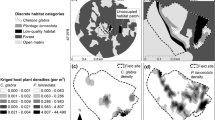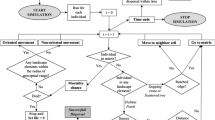Abstract
Despite the importance assigned to inter-patch movements in fragmented systems, the structure of landscape between suitable habitat patches, the matrix, is often considered as to be of minor interest, or totally ignored. Consequently, models predicting metapopulation dynamics typically assume that dispersal and movement abilities are independent of the composition of the matrix. The predictions of such models should be invalided if that crucial assumption is unverified. In order to test the hypothesis of a patch-specific resistance, we led an experimental study to assess the matrix effects on the movement ability of juvenile Natterjack toads (Bufo calamita). The movement behaviour of first year toadlets, the dispersal stage in this species, was investigated in an arena experiment. Toadlet mobility was assessed in five landscape components that were mimicked in the lab: sandy soil, road, forest, agricultural field, and pasture. We analysed several movement components including move length, speed, efficiency and turning angle distribution. Our results showed that movement ability was strongly affected by the land cover, even if body size modulated the behavioural responses of toadlets. Performances were the best in the arenas mimicking sand and roads, and the worst in the forest arena, toadlet moves being three to five times less effective in the latter. The mobility was intermediate in the two other arenas. We propose here a new method to quantify functional connectivity, based on quantitative estimates of relative values for resistance of landscape components. This method offers a reliable alternative for resistance value estimates to subjective ‘expert advice’ or inference from genetic population structure.
Similar content being viewed by others
References
Adriaensen F., Chardon J.P., De Blust G., Swinnen E., Villalba S., Gulinck H. and Matthysen E. 2003. The application of ‘least-cost’ modelling as a functional landscape model. Landscape and Urban Planning 64: 233–247.
Baguette M. and Stevens V. M. 2003. Local populations and metapopulations are both natural and operational categories. Oikos 101: 661–663.
Baguette M., Petit S. and Quéva F. 2000. Population spatial structure and migration of three butterfly species within the same habitat network: consequences for conservation. Journal of Applied Ecology 37: 100–108.
Beck C.W. and Congdon J. D. 2000. Effects of age and size at metamorphosis on performance and metabolic rates of Southern Toad, Bufo terrestris, metamorphs. Functional Ecology 14: 32–38.
Beebee T. J.C. 1979. A review on scientific information pertaining to the Natterjack toad Bufo calamita Throughout its geographical range. Biological Conservation 16: 107–134.
Beebee T.J.C. 1983. The Natterjack Toad. Oxford University Press, Oxford, UK.
Beebee T.J.C. 1985. Geographical variations in breeding activity patterns of the natterjack toad Bufo calamita in Britain. Journal of Zoology 205: 1–8.
Bennett A.F. 1990. Habitat corridors and the conservation of small mammals in a fragmented forest environment. Landscape Ecology 4: 109–122.
Berggren Å., Birath B. and Kindvall O. 2002. effect of corridor and habitat edge on dispersal behavior, movement rate, and movement angles in Roesel's bush-crickets (Metrioptera roeseli). Conservation Biology 16: 1562–1569.
Brooker L., Brooker M. and Cale P. 1999. Animal dispersal in fragmented habitat: measuring habitat connectivity, corridor use and dispersal mortality. Conservation Ecology 3: 4 (onlilne) URL: http://www.consecol.org/vol3/iss1/art4
Brown J.A. and Kodric-Brown A. 1977. Turnover rates in insular biogeography: effect of immigration on extinction. Ecology 58: 445–449.
Chardon J.P., Adriaensen F.and Matthysen E. 2003. Incorporating landscape elements into a connectivity measure: a case study for the Speckled wood butterfly (Parage aegeria L.). Landscape Ecology 18: 561–573.
Charrier S., Petit S. and Burel F. 1997. Movemens of Abax parallelepipedus (Coleoptera, Carabidae) in woody habitats of a hedgerow network landscape: a radio-tracing study. Agriculture Ecosystems and Environment 61: 133–144.
Crist T.O., Guertin D.S., Wiens J.A. and Mline B.T. 1992. Animal movement in heterogeneous landscapes: an experiment with Eleodes beetles in shortgrass prairie. Functional Ecology 6: 536–544.
Denton J.S. and Beebee T.J.C. 1993. Reproductive strategies in a female-biased population of Natterjack toads, Bufo calamita. Animal Behaviour 46: 1169–1175.
Doncaster C.P., Rondinini C. and Johnson P.C.D. 2001. Field test for environmental correlates of dispersal in hedgehogs Erinaceus europaeus. Journal of Animal Ecology 70: 33–46.
Driscoll D.A. 1997. Mobility and metapopulation structure of Geocrinia alba and Geocrinia vitellina, two endangered frog species from southwestern Australia. Australian Journal of Ecology 22: 185–195.
Fahrig L. 2002. Effect of habitat fragmentation on the extinction threshold: a synthesis. Ecological Applications 12: 346–353.
Fahrig L. and Merriam G. 1985. Habitat patch connectivity and population survival. Ecology 66: 1762–1768.
Fahrig L., Pedlar J.H., Pope S.E., Taylor P.D. and Wegner J.F. 1995. Effect of road traffic on amphibian density. Biological Conservation 73: 172–182.
Fisher N.I. 1993. Statistical analysis of circular data. Cambridge University Press, UK.
Gathoye J.L. 1998. Calamites sur Hez. Réserves Naturelles 4: 4.
Goater C.P., Semlitsch R.D. and Bernasconi M.V. 1993. Effects of body size and parasite infection on the locomotory performance of juvenile toads, Bufo bufo. Oikos 66: 129–136.
Goodwin B.J. and Fahrig L. 2002. Effect of landscape structure on the movement behaviour of a specialized goldenrod beetle, Trirhabda borealis. Canadian Journal of Zoology 80: 24–35.
Griffiths R.A. 1997. Temporary ponds as amphibian habitats. Aquatic Conservation 7: 119–126.
Haddad N.M. 1999. Corridor and distance effects on interpatch movements: a landscape experiment with butterflies. Ecological Applications 9: 612–622.
Hanski I.A. and M.E. Gilpin. 1997. Metapopulation Biology: Ecology, Genetics, and Evolution. Academic Press, New York, New York, USA.
Hanski I. 1998. Metapopulation dynamics. Nature 396: 41–49.
Hanski I. 1999a. Metapopulation ecology. Oxford University Press.
Hanski I. 1999b. Habitat connectivity, habitat continuity, and metapopulation in dynamic landscapes. Oikos 87: 209–219.
Hanski I., Alho J. and Moilanen A. 2000. Estimating the parameters of survival and migration of individuals in metapopulations. Ecology 81: 239–251.
Harrison S. 1994. Metapopulations and conservation. In: Edwards P.J., May R.M. and Webb N.R. (eds), Large-Scale Ecology and Conservation Biology. Blackwell Scientific Publications, UK, pp 111-128.
Harrison S., Murphy D.D. and Ehrlich P.R. 1988. Distribution of the bay checkerspot butterfly, Euphydryas editha bayensis: evidence for a metapopulation model. American Naturalist 132: 360–382.
Hill M.F. and Caswell H. 1999. Habitat fragmentation and extinction thresholds on fractal landscapes. Ecology Letters 2: 121–127.
Hitchings S.P. and Beebee T.J.C. 1997. Genetic substructuring as a result of barriers to gene flow in urban Rana temporaria (common frog) populations: implications for conservation. Heredity 79: 117–127.
Ims R.A., and Yoccoz N.G. 1997. Studying transfer processes in metapopulations: emigration, migration, and colonization. In: Hanski I.A. and Gilpin M.E. (eds), Metapopulation Biology: Ecology, Genetics, and Evolution. Academic Press, London, UK, pp 247-265.
Jonsen I. and Taylor P.D. 2000. Fine-scale movement behaviors of calopterygid damselflies are influenced by landscape structure: an experimental manipulation. Oikos 88: 553–562.
Keller L.F. and Weller D.M. 2002. Inbreeding effects in wild populations. Trends in Ecology and Evolution 17: 230–241.
King A.W. and With K.A. 2002. Dispersal success on spatially structured landscapes: when do spatial patterns and dispersal behavior really matter? Ecological Modelling 147: 23–29.
Marsh R.L. 1994. Jumping ability of anuran amphibians. In: Jones J.H. (ed;), Comparative Vertebrate Exercise Physiology: Phyletic Adaptations. Academic Press, London, UK, pp 51–111.
Mennechez G., Schtickzelle N. and Baguette M. 2003. Metapopulation dynamics of the bog fritillary butterfly: comparison of demographic parameters and dispersal between a continuous and a highly fragmented landscape. Landscape Ecology 18, 279–291.
Percsy C., Jacob J.P., Percsy N., de Wavrin H. and Remacle A. 1997. Projet d'atlas herpétologique pour la Wallonie et Bruxelles. Groupe de travail Raînne, Société d'études ornithologiques AVES, Belgium.
Ricketts T.H. 2001. The matrix matters: effective isolation in fragmented landscapes. American Naturalist 158: 87–99.
Rowe G., Beebee T.J.C. and Burke T. 2000. A microsatellite analysis of natterjack toad, Bufo calamita, metapopulations. Oikos 88: 641–651.
Ruckelshaus M., Hartway C. and Kareiva P. 1997. Assessing the data requirements of spatially explicit dispersal models. Conservation Biology 11: 1298–1306.
Rustigian H.L., Santelmann M.V. and Schumaker N.H. 2003. Assessing the potential impacts of alternative landscape designs on amphibian population dynamics. Landscape Ecology 18: 65–81.
Schtickzelle N. and Baguette M. 2004. Metapopulation viability analysis of the bog fritillary butterfly using RAMAS/GIS. Oikos 104: 277–290.
Sinsch U. 1997. Postmetamorphic dispersal and recruitment of first breeders in a Bufo calamita metapopulation. Oecologia 112: 42–47.
Sorci G., Massot M. and Clobert J. 1994. Maternal parasite load increases sprint speed and phylopatry in female offspring of the common lizard. American Naturalist 144: 153–164.
South A. 1999. Dispersal in spatially explicit population models. Conservation Biology 13: 1039–1046.
Stamps J.A., Buechner M. and Krishnan V.V. 1987. The effects of edge permeability and habitat geometry on emigration from patches of habitat. American Naturalist 129: 533–552.
Stephan T., Ulbrich K., Grosse W.R. and Meyer F. 2001. Modelling the extinction risk of isolated populations of natterjackk toad, Bufo calamita. Web Ecology 2: 47–56. (online)
Stevens V.M., Wesselingh R.A. and Baguette M. 2003. Demographic processes in a small, isolated population of Natterjack toads (Bufo calamita) in Southern Belgium. Herpetological Journal 13: 59–67.
Tejedo M. 1992a. Large male mating advantage in natterjack toad, Bufo calamita: sexual selection or energetic constraints? Animal Behaviour 44: 557–569.
Tejedo M. 1992b. Effects of body size and timing of reproduction on reproductive success in female natterjack toads (Bufo calamita). Journal of Zoology 228: 545–555.
Tejedo M., Semlitsch R.D. and Hotz H. 2000. Covariation of Morphology and Jumping Performance in Newly Metamorphosed Water Frogs: Effect of Larval Growth History. Copeia 2000(2): 448–458.
Thomas C.D. and Harrison S. 1992. Spatial dynamics of a patchily distributed butterfly species. Journal of Animal Ecology 61: 437–446.
Turchin P. 1998. Quantitative analysis of movement: measuring and modelling population redistribution in animals and plants. Sinauer Associates, Sunderland, Massachusetts, USA.
Vandewoestijne S. and Baguette M. 2002. The genetic structure of endangered populations in the Cranberry Fritillary, Boloria aquilonaris (Lepidoptera, Nymphalidae): RAPDs vs allozymes. Heredity 89: 439–445.
Wiens J.A. 1997. Metapopulation dynamics and landscape ecology. In: Hanski I.A. and Gilpin M.E. (eds), Metapopulation Biology: Ecology, Genetics, and Evolution. Academic Press, London,UK, pp 43-62.
Wiens J.A. 2001. The landscape context of dispersal. In: Clobert J., Danchin E., Dhondt A.A. and Nichols J.D. (eds), Dispersal. Oxford Univ. Press, Oxford, UK, pp 96-109.
Wiens J.A. and Milne B.T. 1989. Scaling of ‘landscapes’ in land-scape ecology, or, landscape ecology from a beetle's perspective. Landscape Ecology 3: 87–96.
Wiens J.A., Schooley R.L. and Weeks R.D. 1997. Patchy landscapes and animal movements: Do beetles percolate? Oikos 78: 257–264.
Wilcox B.A. and Murphy D.D. 1985. Conservation strategy: the effect of fragmentation on extinction. American Naturalist 125: 879–887.
With K.A. 1994. Ontogenic shifts in how grasshoppers interact with landscape structure–an analysis of movement pattern. Functional Ecology 8: 477–485.
With K.A., Cadaret S.J. and Davis C. 1999. Movement responses to patch structure in experimental fractal landscapes. Ecology 80: 1340–1353.
Author information
Authors and Affiliations
Rights and permissions
About this article
Cite this article
Stevens, V.M., Polus, E., Wesselingh, R.A. et al. Quantifying functional connectivity: experimental evidence for patch-specific resistance in the Natterjack toad (Bufo calamita). Landscape Ecology 19, 829–842 (2004). https://doi.org/10.1007/s10980-004-0166-6
Issue Date:
DOI: https://doi.org/10.1007/s10980-004-0166-6




